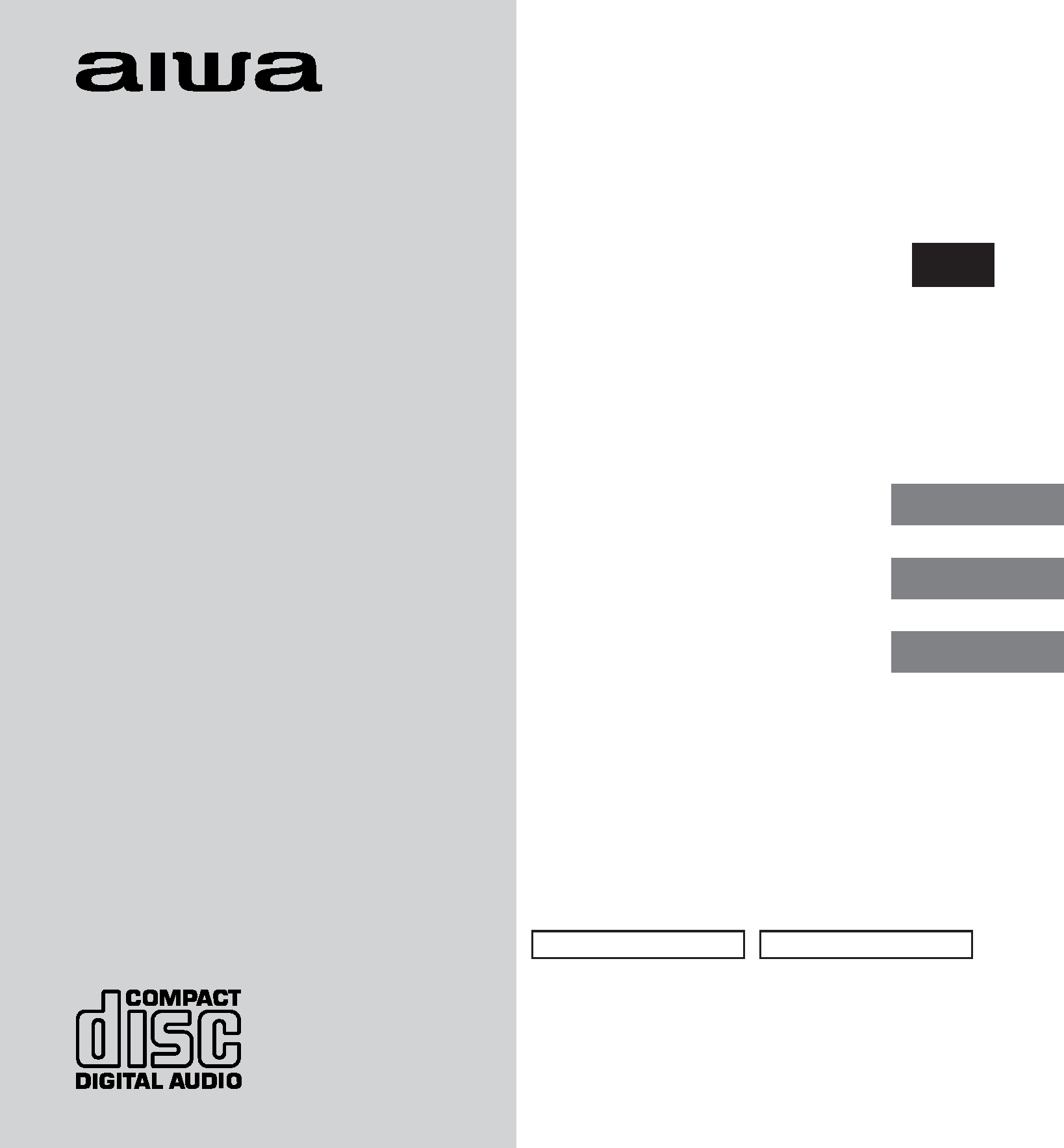
XP-Z5C YUC
COMPACT DISC
PLAYER
REPRODUCTOR DE
DISCOS
COMPACTOS
LECTEUR DE DISQUE
COMPACT
8C-HP5-901-01
011210AMK-O-B
Printed in China
OPERATING INSTRUCTIONS
INSTRUCCIONES DE MANEJO
MODE D'EMPLOI
ENGLISH
ESPAÑOL
FRANÇAIS
OWNER'S RECORD
For your convenience, record the model number
and the serial number (you will find it inside the
battery compartment of your set) in the space
provided below. Please refer to them when you
contact your Aiwa dealer in case of difficulty.
Model No. XP-Z5C
Serial No.

2 ENGLISH
To maintain good performance
· DO NOT use the unit in places that are
extremely hot, cold, dusty, or humid. In
particular, DO NOT use or keep the unit in
the following places:
In a high-humidity area such as a
bathroom
Near a heater
In an area exposed to direct sunlight (e.g.
inside a parked car, where it can become
extremely hot)
Near sources of strong magnetism, such
as televisions, speakers, or magnets
Where there is a lot of movement or
vibration, such as on a car dashboard or
an unstable shelf
· Before connecting the AC adaptor or the
headphones, etc., be sure to confirm that
the power is off.
For safety
· DO NOT attempt to disassemble the unit.
Laser light from the optical pickup is
dangerous to the eyes.
· Make sure that pins or other foreign objects
do not get inside the unit.
· Take care not to drop the unit or subject it
to strong shock.
· To keep dust off the pickup lens, keep the
disc compartment lid closed after use.
NEVER touch the lens.
PRECAUTIONS
WARNING:
TO REDUCE THE RISK OF FIRE OR
ELECTRIC SHOCK, DO NOT EXPOSE
THIS APPLIANCE TO RAIN OR
MOISTURE.
TABLE OF CONTENTS
PRECAUTIONS ........................................... 2
NOTES ON MP3 DISCS .............................. 4
POWER SOURCES ..................................... 6
BEFORE PLAYBACK .................................. 8
PLAYBACK ................................................ 11
OTHER PLAYBACK FUNCTIONS ............ 13
E·A·S·S PLUS (Electronic Anti-Shock
System) function .................................... 13
Sound equalizer ..................................... 13
Selecting a playback mode .................... 14
Program play .......................................... 16
CONNECTIONS ........................................ 20
MAINTENANCE ......................................... 22
TERMINOLOGY ........................................ 23
SPECIFICATIONS ..................................... 24

ENGLISH
3
ENGLISH
· If you hear no sound when playing a disc,
DO NOT turn the volume up high, because
music could suddenly start at high volume.
Turn the volume control to the lowest level
before starting playback and slowly turn it
up to the desired level.
·When using a commercially available AC
adaptor, use one whose rated output is DC
56 V, 250300 mA.
Notes on listening with the
headphones
·Listen at moderate volume levels to avoid
hearing damage.
· DO NOT wear the headphones while driving
or cycling. It may create a traffic hazard.
· You should use extreme caution or
temporarily discontinue use in potentially
hazardous situations, such as walking,
jogging, etc.
·Wear them properly: L is left, R is right.
CAUTION
Listening with headphones at high volume
levels for an extended period of time can
result in hearing damage.
Note on condensation
If the unit is suddenly moved from a cold
place to a warm one, it may result in
condensation on the pickup lens and
malfunction or playback difficulties.
Should this occur, leave the unit for a few
hours, then try to playback again.
Notes on the car audio cassette
adaptor
·NEVER remove the protective film from
the head or the white dummy tape from the
car audio cassette adaptor.
·Clean the head of the cassette car stereo
regularly for optimum sound quality.
·Gather and secure the excess cord so that
it does not interfere with driving.
Notes on the car battery adaptor
· The car battery adaptor is designed for
negative-ground 12 V/24 V cars. It cannot
be used with positive-ground cars.
· In some cars, electric current will continue
to flow through the car battery adaptor
even though the car ignition switch is turned
off. This will cause discharge of electricity.
Disconnect the car battery adaptor from
the cigarette lighter socket when not in
use.
· Power may shut off if the DC output plug of
the car battery adaptor touches metal parts
of the car. Disconnect it from the cigarette
lighter socket when not in use.
· Should any trouble occur (such as the car
battery adaptor emitting smoke), disconnect
it from the cigarette lighter socket
immediately and contact an Aiwa service
representative.

4 ENGLISH
NOTES ON MP3 DISCS
· An MP3 file stores audio data
compressed using MPEG1/2, the audio
layer-3 file-coding scheme.
· In this manual, CDs, CD-R discs and
CD-RW discs are all referred to as
"discs." We refer to what are called
"folders" and "files" in PC terminology
as "albums" and "tracks."
Notes on playing MP3 files
· An MP3 track must be recorded on a disc
in the format compliant with ISO 9660.
Note, however, that the unit may not play
tracks in the order in which they were
recorded.
· The maximum allowable number of tracks
and albums on a disc are as follows:
Number of tracks: 199 (depending on the
number of albums)
Number of albums: up to 99 (depending
on the number of tracks)
· The maximum allowable depth of nested
albums is 8.
·E·A·S·S PLUS memory duration is
approximately 400 seconds at the longest
with tracks of 128-kbps bit rate.
· It may take 30 seconds or more before the
unit can start play of a MP3 track, depending
on the number of recorded tracks and the
complexity of the album tree.
· If a disc contains audio (CD-DA) tracks and
MP3 tracks, the unit plays only the audio
tracks.
· The unit may not play MP3 tracks recorded
using a packet writing utility.
· The unit can play MP3 tracks having the
filename extension ".mp3."
· If you play a non-MP3 track that has the
".mp3" filename extension, you may hear
some noise.
· This unit can play back MP3 tracks of the
following
bit
rates
and
sampling
frequencies:
MPEG1: 32320 kbps,
32 kHz, 44.1 kHz, 48 kHz
MPEG2: 16160 kbps,
16 kHz, 22.05 kHz, 24 kHz
· This unit is best-suited for playback of
tracks with a bit rate of 128 kbps. The
sound may be intermittent or distorted
during playback of tracks encoded with a
certain encoder or encoded with bit rate
over 128 kbps.
· The elapsed playing time may not be
displayed correctly when variable-bit-rate
(VBR) files are played.

ENGLISH
5
ENGLISH
· Sound is muted for a moment with a disc
that contains no silent portion between
songs (tracks), such as a disc with a
recording of a live performance, etc.
·When files encoded with the MP3 Pro
format are played back, their sound quality
may not be as high as they should be.
Note on display indications during
play
This unit does not support ID3 TAG, and the
information such as album names and track
names cannot be displayed.
Notes on creating MP3 discs
When converting audio data to MP3
To enjoy high sound quality, we recommend
storing MP3 files with a sampling frequency
of 44.1 kHz and a fixed bit rate of 128 kbps.
To play tracks in the order they were
recorded
1 Use writing software capable of
recording MP3 tracks (files) in
numerical and alphabetical order.
For details on using the software, refer to
the operating instructions supplied with
the software.
2 Use only one album. (Do not create
a subalbum within an album.)
3 Include a two- or three-digit number
at the beginning of each album or
track name so that the albums and
tracks will be played in order.
Examples of recommended names:
01XXXXX.mp3
02XXXXX.mp3
03XXXXX.mp3
04XXXXX.mp3
05XXXXX.mp3
Examples of names not recommended:
1XXXXX.mp3
5XXXXX.mp3
10XXXXX.mp3
15XXXXX.mp3
20XXXXX.mp3
(Numbers at the beginning have
different digit number. The tracks will
not be played in this order but played
in the order of "1," "10," "15," "20," and
"5.")
